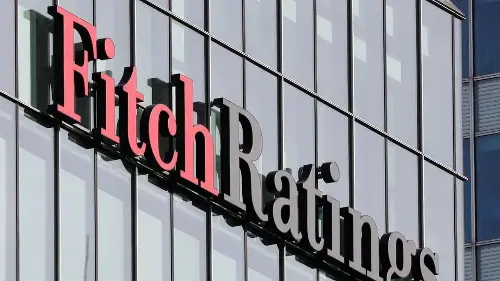
New Delhi: India’s economic growth is expected to remain resilient during FY26, supported by sustained government spending and a potential revival in private investments, several rating agencies said in their FY25 rating assessments released on Tuesday, but warned of risks to exports from escalating US tariffs and a widening trade war.
India Ratings & Research, a Fitch Group company, said it expects the economy to grow at 6.6% in FY26, but warned that rating actions could moderate during the fiscal year. Rating actions encompass all changes made by a credit rating agency, including initial assignments, revisions, outlook changes, suspensions, and withdrawals.
According to the rating agency, sectors like power, auto and auto components, road infrastructure, consumer services, and healthcare have performed well with rating upgrades over the past four years, driven by government-led infrastructure investments and strong urban demand.
Also read | When will global credit rating agencies get their assessments of India right?
Improving rural consumption, supported by higher disposable incomes, has further boosted the services sector. However, textiles, construction, and capital goods have faced downward rating actions due to raw material price volatility and rising working capital pressures.
During FY25, India Ratings upgraded 330 issuers of debt, while downgrading 94.
"Sound domestic consumption demand amidst an uptick in rural demand, continued government focus on capex spending and strong services growth supported robust economic growth," India Ratings & Research said in its Corporate Credit Profile FY25 report.
"However, macroeconomic instability from pockets of demand slowdown, rising delinquencies in retail credit, and uncertainties from United States tariff hikes in the last quarter constrained the momentum...Evolving landscape from tariff war and its possible ensuing impact on credit profiles set a cautious tone," it added.
Domestic demand to strengthen
Meanwhile, Crisil Ratings said in its H2, FY25 Ratings Roundup that the credit quality outlook for Indian firms is expected to be positive for FY2026, as domestic demand is expected to strengthen across three key sectors of the economy – capital goods, construction and retail.
On the upcoming US reciprocal tariffs, slated to come into effect from 2 April, Crisil Ratings expect sectors, other than smartphones, to see low to moderate impact on their business risk profiles as strong corporate balance sheets will provide adequate room to absorb this impact without affecting credit quality.
Also read | Mint Primer | Sovereign rating: How India can go from B to A
A blanket 25% US tariff on steel, aluminium, and auto components is expected to have a moderate impact, though direct US market dependence is low, the rating agency said.
Crisil Ratings said as many as 409 upgrades and 228 downgrades were recorded for domestic companies during the period, with the credit ratio standing at 2.64 times during H2, FY25, a tad lower than 2.75 times in the first half.
"Corporate India would benefit from the urban consumption spur driven by budgetary tax cuts, easing inflation and expected reduction in interest rates," said Subodh Rai, Managing Director, Crisil Ratings.
"Further, steadfast spending on infrastructure will have a positive multiplier effect and support linked sectors," he added.
Goods exports may be modest
According to the rating agency Icra, the tepidness in India’s merchandise exports is expected to continue in the near term amid the ongoing tariff tussles with services export growth likely to outpace merchandise export growth.
During FY24, India's merchandise exports stood at about $427 billion, down 3.1% annually, while imports stood at about $678 billion, down 5.27% annually, according to data from the commerce and industry ministry.
Indian tariffs are relatively high compared to many other countries.
India’s ‘Most Favoured Nation or MFN-applied trade-weighted average tariff rate’ stands at 12%, according to the World Trade Organisation. By comparison, the rate for others are as follows: Korea (8.4%), Brazil (6.7%), Indonesia (5.3%), China (3.0%), Mexico (3.9%), the EU (2.7%), Canada (3.4%), and the US (2.2%).
Also read | Govt to roll out credit rating for rural borrowers in six months
"While product-wise tariffs vary, the comparison above provides a simplified view of the tariff differentials between India and the US. Given the possibility of reciprocal tariffs being levied by the US on India (as has been done on other countries), Indian exporters will need to navigate trade flow adjustments," Icra said.
"Additionally, US tariff actions are likely to exert downward pressure on the INR against the USD, which could partially offset the impact on export revenues in INR terms," it added.
Icra said that while the overall consumption growth had lagged behind GDP growth in FY23 and FY24, the uptick in FY25 has been driven mostly by rural demand, with urban demand growth remaining modest.
However, a recovery is expected in FY26 with tax relief announced in the annual budget, lower food inflation, rate cuts, and other enablers, the rating agency added.
Global uncertainty could impact private capex
The imposition of US tariffs could disrupt export-driven sectors, particularly those reliant on discretionary spending, and lead to increased price competition from other affected economies, said Sachin Gupta, executive director and chief rating officer at CareEdge Ratings, adding that the uncertainty may keep private sector capital expenditure on hold until clearer signals emerge.
"That said, not all is bleak—trade agreements and rupee depreciation could offer much-needed relief to exporters. At the same time, Corporate India’s strong, deleveraged balance sheets act as a sturdy shield against external volatility," Gupta added.
CareEdge Ratings’ Credit Ratio improved to 2.35 times in H2 FY25, up from 1.62 times in H1 FY25, with 386 upgrades and 164 downgrades during the period.